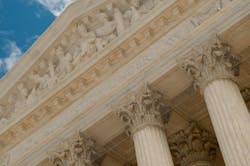Supreme Court considers jurisdiction of Clean Water Act
The US Supreme Court heard arguments Oct. 3 over whether the determination of Clean Water Act jurisdiction should be revised—a case that could have consequences for determining whether an oil and gas project or any other project falls inside the reach of federal water regulators.
The underlying problem is that Congress has never defined the jurisdiction of the act in terms of specifics about what wetlands and isolated ponds fall within the authority of the Environmental Protection Agency (EPA) and the US Army Corps of Engineers, the two agencies that administer the act.
Before the Supreme Court, attorney Damien Schiff of Pacific Legal Foundation argued for property owners Michael and Chantell Sackett that the court should require a much clearer legal line to separate jurisdictional and non-jurisdictional wetlands.
The justices did not indicate they will agree to draw such a line. Instead, they kept raising questions about where the line should be and what portions of the law might support such an interpretation.
At present, EPA and the Corps of Engineers are trying to apply a case-by-case “significant nexus” test—a test of whether a wetland has a significant ecological connection to a federal water body.
The Sacketts are hoping the court will adopt an opinion recommended by four justices in the court’s 2006 case Rapanos v. US, an opinion that would require a continuous surface water connection between a wetland and the federal “navigable waters” of the US.
The split decision in the Rapanos case prevented the opinion of the four-justice plurality from serving as the controlling test used by regulators to determine jurisdiction.
“This test is vastly superior to the significant nexus test,” Schiff argued. “It’s an easily administered test.”
The plaintiffs’ position was supported earlier this year in a court brief filed jointly by the American Petroleum Institute, the Association of Oil Pipe Lines, and the American Gas Association.
The jurisdiction issue can affect such oil industry responsibilities as pipeline routes and spill prevention control and countermeasures, an industry official said when the case was accepted for review by the Supreme Court (OGJ Online, Jan. 24, 2022).
What is adjacent?
Justices pushed Schiff repeatedly on the fact that one sentence in the Clean Water Act refers to adjacent wetlands, and that the 1985 Supreme Court decision in US v. Riverside Bayview Homes Inc. supported the idea that wetlands adjacent to navigable waters were jurisdictional under the act.
The attorney responded that the one sentence in the law and the 1985 ruling did not define all adjacent wetlands as jurisdictional. The one sentence and the 1985 ruling did not attempt to distinguish between wetlands with differing degrees of connection and distance to navigable waters, he said.
The question came up again and again during the arguments: What is adjacent? Does it require physical contact? Does it include nearby or neighboring? Is there a metric for geographic proximity?
Related questions also arose repeatedly: What about wetlands that usually are wet but dry up for a few months in summer? What about subsurface connections between wetlands and navigable waters?
Schiff acknowledged there are gradations of difference that create ambiguities in determining jurisdiction. He argued that those ambiguities have not been cleared up by the “significant nexus” test. That test has led to repeated attempts by EPA and the Corps of Engineers to revise their regulations, and courts have produced conflicting decisions on the subject.
In the Sacketts’ case, the US Court of Appeals for the Ninth Circuit has sided with federal regulators in ruling that the couple must get Corps of Engineers approval to build a house on their property.
Costs and uncertainties
The plaintiffs’ attorney said would-be developers may have to pay sizable amounts, sometimes hundreds of thousands of dollars, for environmental consultants and other permitting expenses. Regulators also can insist on compensatory mitigation, and that, in aggregate, is costing parties billions of dollars a year, Schiff said.
The risk of criminal prosecution also can hang over the heads of plaintiffs, he said.
The federal policies are not as unclear or as expensive as the plaintiffs suggest, argued attorney Brian Fletcher of the US solicitor general’s staff.
Fletcher said the government uses the significant nexus test combined with a judgment of “reasonable proximity,” another phrase without a precise definition.
In the Sacketts’ case, their property is in a residential subdivision and is about 300 feet from Priest Lake, Idaho, which is accepted by all parties as a federal jurisdictional water body. The property is 30 feet from a tributary of the lake, and the government is hinging its case on that shorter distance.
As for expense, Fletcher said the federal regulators offer their jurisdictional determinations for free.



